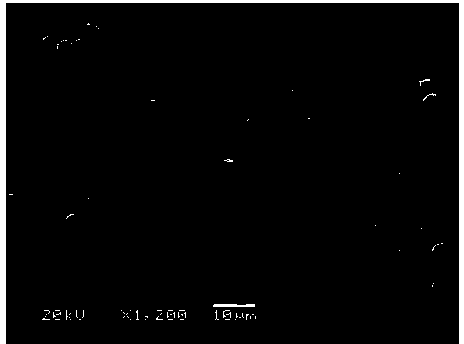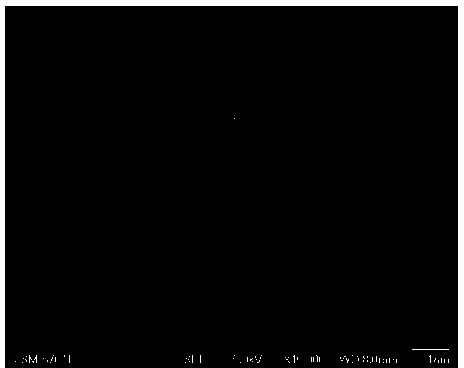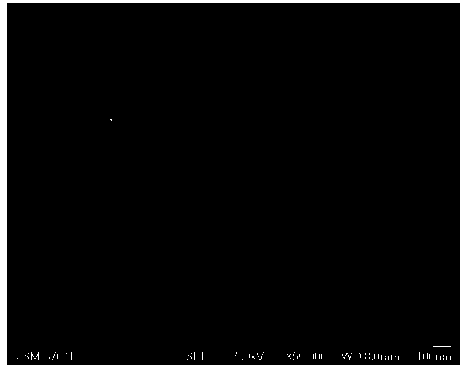Preparation method of porous carbon microsphere
A technology of porous carbon and microspheres, which is applied in the field of preparation of porous carbon microspheres, can solve the problems of cumbersome and unsatisfactory preparation methods, and achieve the effects of cheap preparation of raw materials, uniform particle size and no special equipment requirements.
- Summary
- Abstract
- Description
- Claims
- Application Information
AI Technical Summary
Problems solved by technology
Method used
Image
Examples
Embodiment 1
[0032] Example 1: Porous carbon microspheres with an average particle size of 8.1 μm
[0033] Include the following six steps in order:
[0034] ① Mix 2.20g catechol, 2.03g formaldehyde aqueous solution (37wt%), and 19.2g silica sol (36nm, 16.2wt%) evenly, and adjust the pH to 1.60 with hydrochloric acid.
[0035] ② Under the protection of nitrogen, the reaction was rapidly stirred at 60°C. The reaction was monitored with an optical microscope until the microspheres no longer grew larger, then the reaction was stopped and cooled to room temperature.
[0036] ③ Centrifuge the suspension obtained in step ②, wash the precipitate three times with distilled water, dry it in vacuum at 110°C for 8 hours, and cool to room temperature.
[0037] ④ The above dried composite microspheres were sintered at high temperature under the protection of nitrogen. The sintering steps are as follows: raise the temperature from room temperature to 350°C within 30 minutes, keep at 350°C for 2 h...
Embodiment 2
[0040] Example 2: Porous carbon microspheres with an average particle size of 4.5 μm
[0041] Include the following six steps in order:
[0042] ① Mix 2.75 g catechol, 2.03 g formaldehyde aqueous solution (37wt%), and 23.0 g silica sol (36nm, 16.2wt%) evenly, and adjust the pH to 1.80 with hydrochloric acid.
[0043]② Under the protection of nitrogen, the reaction was rapidly stirred at 60°C. The reaction was monitored with an optical microscope until the microspheres no longer grew larger, then the reaction was stopped and cooled to room temperature.
[0044] ③ Centrifuge the suspension obtained in step ②, wash the precipitate three times with distilled water, dry it in vacuum at 110°C for 8 hours, and cool to room temperature.
[0045] ④ The above dried composite microspheres were sintered at high temperature under the protection of nitrogen. The sintering steps are as follows: raise the temperature from room temperature to 350°C within 30 minutes, keep at 350°C for 2...
Embodiment 3
[0048] Example 3: Porous carbon microspheres with an average particle size of 7.8 μm
[0049] ① Mix 1.50g catechol, 1.37g formaldehyde aqueous solution (37wt%), and 19.2g silica sol (100nm, 13.5wt%) evenly, and adjust the pH to 1.60 with sulfuric acid.
[0050] ② Under the protection of nitrogen, the reaction was rapidly stirred at 60°C. The reaction was monitored with an optical microscope until the microspheres no longer grew larger, then the reaction was stopped and cooled to room temperature.
[0051] ③ Centrifuge the suspension obtained in step ②, wash the precipitate three times with distilled water, dry it in vacuum at 110°C for 8 hours, and cool to room temperature.
[0052] ④ The above dried composite microspheres were sintered at high temperature under the protection of nitrogen. The sintering steps are as follows: raise the temperature from room temperature to 350°C within 30 minutes, keep at 350°C for 2 hours, continue to raise the temperature, rise to 600°C ...
PUM
| Property | Measurement | Unit |
|---|---|---|
| particle size | aaaaa | aaaaa |
| particle size | aaaaa | aaaaa |
| particle size | aaaaa | aaaaa |
Abstract
Description
Claims
Application Information
 Login to View More
Login to View More - R&D
- Intellectual Property
- Life Sciences
- Materials
- Tech Scout
- Unparalleled Data Quality
- Higher Quality Content
- 60% Fewer Hallucinations
Browse by: Latest US Patents, China's latest patents, Technical Efficacy Thesaurus, Application Domain, Technology Topic, Popular Technical Reports.
© 2025 PatSnap. All rights reserved.Legal|Privacy policy|Modern Slavery Act Transparency Statement|Sitemap|About US| Contact US: help@patsnap.com



